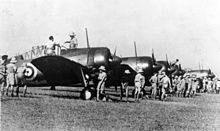No. 21 Squadron RAAF
Summers, the squadron had a cadre of regular RAAF personnel who served alongside the part-time members of the CAF and initially operated a variety of aircraft including Hawker Demons, Westland Wapitis and de Havilland Gipsy Moths.
[1] Following this, the squadron undertook similar missions in the Great Australian Bight, providing protection for ships sailing for Europe.
[3] Initially, the squadron operated Demons, Ansons, Avro Cadets and a North American NA-16; shortly afterwards it was re-equipped with the Australian-built CAC Wirraway and switched to an army co-operation role.
[1][4] In August 1940, the squadron was dispatched to Seletar, on Singapore, where it operated its Wirraways in support of ground forces that had been stationed there amid concerns of war with the Japanese.
[1] In mid-1941, as war with Japan became more likely, the squadron was sent to Malaya, operating out of Sungai Petani, where they augmented four other British Commonwealth, including No.
[3] The five British Commonwealth units—including two RAF and one Royal New Zealand Air Force squadrons—that flew Buffalos in the Malayan campaign were beset with numerous problems, including poorly built and ill-equipped planes;[5][6] inadequate supplies of spare parts;[6] inadequate numbers of support staff;[5][6] airfields that were difficult to defend against air attack;[5] lack of a clear and coherent command structure;[5] antagonism between RAF and RAAF squadrons and personnel,[5][6] and inexperienced pilots lacking appropriate training.
[5] The squadron's involvement in the fighting came on 8 December 1941, following a heavy Japanese bombing raid on Sungai Petani, which resulted in the loss or damage of several of its aircraft.
[1] Initial interception operations proved unfruitful and, as a result of heavy damage to the airfield, the squadron was withdrawn to Ipoh, falling back through Butterworth, where they squadron achieved its first air-to-air victory, when a Buffalo piloted by Flying Officer Harold Montefiore shot down a Mitsubishi A6M Zero single-engined fighter.
Later, on 26 January, two more Japanese fighters were destroyed and another possibly shot down during a bomber escort mission over Endau.
21 Squadron was re-formed at Gawler, South Australia, and re-equipped with Vultee Vengeance dive bombers.
[8] Supply dumps and concentrations of troops were also attacked and the squadron took part in large air raids on the Japanese airstrips at Hansa Bay, Madang and Alexishafen in concert with Nos.
[3][7] Following further attacks in March against Japanese camps around Pommern Bay and Rempi village, the Vengeance was withdrawn from front-line operational service in New Guinea, as Allied commanders deemed its short flying range unsuitable for the conditions.
82 Wing RAAF,[10] it attacked targets at Laga and a radio station at Moena Island, operating out of Fenton.
In the final months of the war the squadron's last operations were concentrated around supporting the Allied landings at Labuan and Balikpapan.
[3] Following the end of the war the unit's aircraft were used as shipping escorts and as transports before returning to Tocumwal, New South Wales.



